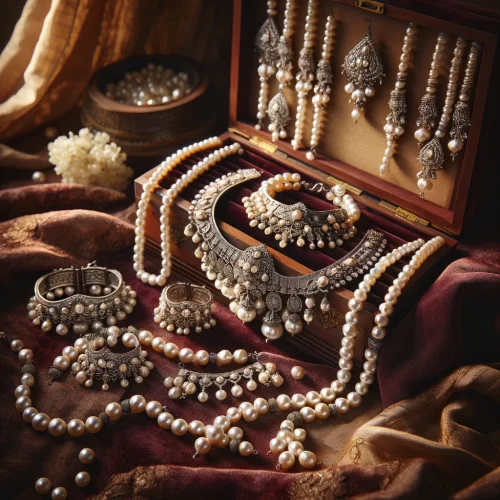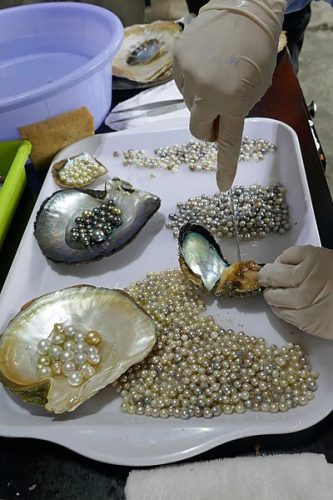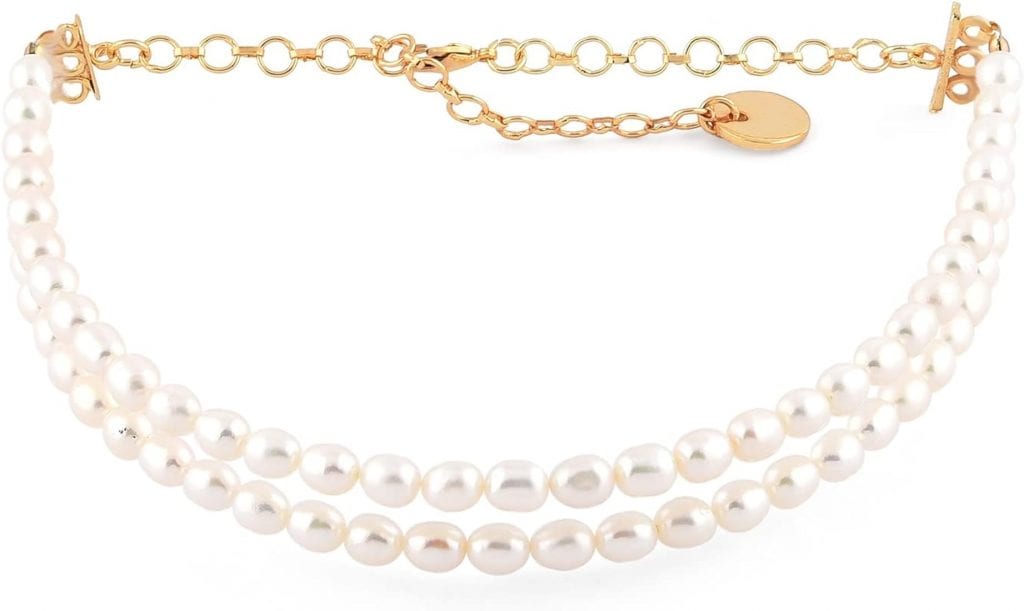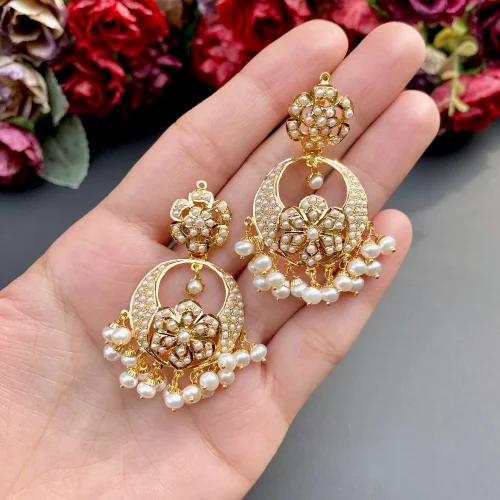Hyderabadi Pearl Jewellery combines centuries-old craftsmanship with a rich historical backdrop, creating exquisite pieces that are both timeless and elegantly sophisticated.

Hyderabad, known as the “City of Pearls,” stands as a testament to its rich cultural tapestry and the intricate craftsmanship of its pearl jewellery. This city, India’s premier pearl trading hub, is famous not only for its beautiful jewellery but also for its deep historical roots in the pearl trade.
The nearby village of Chandanpet, where nearly the entire population is dedicated to the skilled craft of pearl drilling—a practice passed down for generations—highlights this tradition. Such dedication has made Hyderabad one of the largest pearl drilling locations in the country.
The flourishing of the pearl industry in Hyderabad was significantly supported by the patronage of the Qutub Shahi kings and the Asaf Jahis. Their love for sparkling jewels helped establish the city as a centre for exquisite pearl jewellery.
Notably, pearls were traditionally part of the royal regalia and believed to possess healing and beautifying properties. Mir Osman Ali Khan, one of the wealthiest Nizams, famously stored sacks of pearls in his palace basements. During their birthdays, princesses were weighed against pearls, underscoring the deep cultural significance of these gems.
Historically, Hyderabad’s rise as a pearl trading centre came after the decline of the pearl industry in Basra, Iraq. Initially, pearls were imported from Basra, valued for their hardness compared to the softer, less durable pearls from the Bay of Bengal.
However, the advent of the oil industry and subsequent pollution in the Persian Gulf diminished Basra’s pearl trade, leading merchants and skilled artisans to relocate to Hyderabad.
This migration enriched Hyderabad’s practices, with artisans continuing to hand down traditional pearl cultivation and jewellery-making techniques through generations.
Today, pearl jewellery in Hyderabad is celebrated worldwide for its lustrous sheen and delicate beauty. More than mere adornments, these jewels are cherished heirlooms that weave together the history and heart of an ancient city, making Hyderabadi pearls a symbol of heritage and timeless elegance.
Here we explore the origin, craftsmanship, and stunning variety of ornaments that make Hyderabadi pearls a coveted treasure in both traditional ceremonies and high fashion.
The Process:

The crafting of pearl jewellery in Hyderabad begins with the skilled Kharradars, master craftsmen who incorporate age-old family techniques of drilling, sorting, and stringing into their work. These artisans, integral to the city’s heritage, first drill the pearls, which are then boiled for about four days to bleach and remove their dark colour.
Next, the pearls are placed in glass bottles containing a mix of hydrogen peroxide, water, and ether and left in the sun for four to five days in glass sun boxes with mirrored bases. After sunning, the pearls are washed and meticulously sorted by shape and size.
Pearls, often called the “Queen of Jewels,” hold a revered place in Hyderabad’s culture. Their romantic allure and unmatched lustre have made them a favourite among women for generations. Pearls are categorized into two types: real or cultured.
Each pearl is carefully drilled, either horizontally or vertically, and graded on aspects like sheen, glaze, shape, size, lustre, and uniformity.
In recent developments, many pearl producers in Hyderabad have begun exporting processed pearls to markets in Europe and the US. The profits from these sales are reinvested into purchasing advanced machinery for pearl refining.
This new equipment often uses enzymes from thermophiles, which significantly improves the pearl refining process, ensuring the continuation of Hyderabad’s legacy in the global pearl market.
Famous pieces of pearl jewellery in Hyderabad :
Rassi

The Rassi is a distinguished piece of pearl jewellery in Hyderabad, featuring a long, elegant rope design. This ornament is crafted with multiple strands of finely drilled pearls, expertly woven to create a sleek, flowing effect. It’s a versatile piece, often worn in both traditional and contemporary settings, symbolizing grace and sophistication.
Chandbali

The Chandbali, a quintessential jewellery piece, epitomizes the city’s regal heritage. Resembling the shape of a crescent moon, these earrings are adorned with lustrous pearls and often complemented by other gemstones. The intricate metalwork and pearl embellishments reflect traditional craftsmanship, making Chandbali a sought-after accessory for its elegance and ability to add a royal touch to any ensemble.
Chatai

The Chatai is a remarkable piece of jewellery, known for its distinctive mat-like design. It features tightly woven rows of small, shiny pearls that create a flat, textured surface similar to a woven mat. Renowned for its fine craftsmanship and elegance, the Chatai showcases the skilled artistry of Hyderabadi jewellers and is a prized piece in traditional jewellery collections.
Vaddenam
The Vaddenam is a striking piece of pearl jewellery, serving as a traditional waist belt that adorns ceremonial attire. This ornate belt is elaborately decorated with pearls, often interspersed with precious stones and intricate gold work. Designed to showcase wealth and status, the Vaddenam is a masterpiece of craftsmanship.
Panchlada
The Panchlada is an elegant Hyderabadi pearl necklace, distinguished by its five-layered strand design. Each strand is meticulously adorned with fine pearls, often interspersed with precious gems to enhance its allure. This traditional piece symbolizes grace and opulence, making it a favourite for brides and an essential in formal Hyderabadi attire.
Satlada
The Satlada is a luxurious Hyderabadi pearl necklace that features seven cascading strands of pearls, embodying opulence and grandeur. This elaborate piece is often interwoven with gold and punctuated with precious gemstones to enhance its splendour. Traditionally worn by royalty, the Satlada is a testament to the exquisite craftsmanship of Hyderabadi artisans and remains a popular choice for weddings and formal occasions.
Chandra Haar
Characterized by its moon-like pendants on multiple pearl strands, this necklace is a wedding favourite, believed to bring peace and joy to the wearer. These ornaments are not merely decorative; they are steeped in cultural significance, often worn during weddings and festivals, symbolizing purity, elegance, and a connection to Hyderabad’s royal heritage.
Jhumka
The Jhumka is a classic piece of pearl jewellery, characterized by its iconic bell shape. Adorned with layers of fine pearls, these earrings are designed to gracefully dangle and shimmer with every movement. Embellished often with gold and other gemstones, Jhumkas add a touch of traditional elegance to any outfit, making them a beloved choice for festive occasions and bridal wear alike.
Tikka
Tikka is a stunning pearl jewellery piece worn on the forehead. It consists of a delicate chain with a central pearl pendant that sits beautifully on the forehead, usually starting from the hairline. Often decorated with pearls and sometimes precious stones, the Tikka adds elegance and is frequently worn at weddings and festive events.
Adapting to global fashion trends
Pearl jewellery in Hyderabad, known for its distinctive designs like the elegant Satlada, regal Chandbali, and intricate Chatai, not only epitomizes traditional craftsmanship but also embraces modern aesthetics. These timeless pieces serve as a bridge between the rich heritage of the past and contemporary style, adapting to global fashion trends while maintaining their cultural essence.
As collectors and fashion enthusiasts worldwide admire these jewels, from the layered Panchlada to the stately Vaddenam, the future of this ancient art form sparkles with promise. It stands poised to continue its legacy, ensuring that Hyderabadi pearl jewellery remains both vibrant and relevant in the evolving world of fashion.
It is astonishing how Hyderabadi pearl jewellery, known for its distinctive traditional designs like the elegant Satlada, regal Chandbali, and intricate Chatai, has progressed to embrace modern aesthetics. These timeless pieces serve as a bridge between the rich heritage of the past and contemporary style, adapting to global fashion trends while maintaining their cultural essence.
As collectors and fashion enthusiasts worldwide admire these jewels, from the layered Panchlada to the stately Vaddenam, the future of this ancient art form sparkles with promise. It stands poised to continue its legacy, ensuring that pearl jewellery in Hyderabad remains both vibrant and relevant in the evolving world of fashion.
As modern demands evolve, the pearl industry in Hyderabad is adapting, blending its craftsmanship with contemporary designs to meet the global market. The future of this luminous craft looks promising, bridging the past with the present, and continuing to enchant the world with its timeless beauty.
How to check if a pearl is real
To determine if a pearl is real, you can use several methods that test its authenticity. Here are some key points to consider:
Luster Test:
- Real pearls have a deep, luminous sheen, meaning they reflect light beautifully and have a glowing surface.
- Fake pearls often have a surface that’s too shiny or too dull, lacking the subtle inner light of real pearls.
Texture Test:
- Run the pearl gently along the edge of your teeth. Real pearls usually have a slightly gritty or sandy texture due to their natural layers.
- Fake pearls, made from glass or plastic, will feel smooth and glasslike.
Shape and Size:
- Genuine pearls are rarely perfect. They often have slight irregularities in shape or minor variations in size.
- Perfectly round and identical pearls are often a sign of manufacturing.
Temperature Test:
- Real pearls usually feel cool to the touch initially and warm up slowly when held.
- Synthetic pearls tend to be at room temperature consistently.
Weight Test:
- Real pearls have a noticeable weight when held. They should feel heavier than they look.
- Fake pearls are typically lighter and feel less substantial.
Drill Hole Examination:
- Look closely at the drill holes. Real pearls typically have sharp and clean edges around the holes, and you might see slight ridges inside.
- Fake pearls often have painted drill holes that can peel or show signs of chipping around the edges.
Rub Test:
- Rub two pearls gently against each other. Real pearls will give off a powder-like substance and still maintain their sheen.
- Synthetic pearls will feel smooth against each other and won’t produce powder.
These tests can provide clues about a pearl’s authenticity. However, for a definitive answer, especially if the pearls are valuable, it’s wise to have them appraised by a professional jeweller or gemologist.
Read more: Latest



